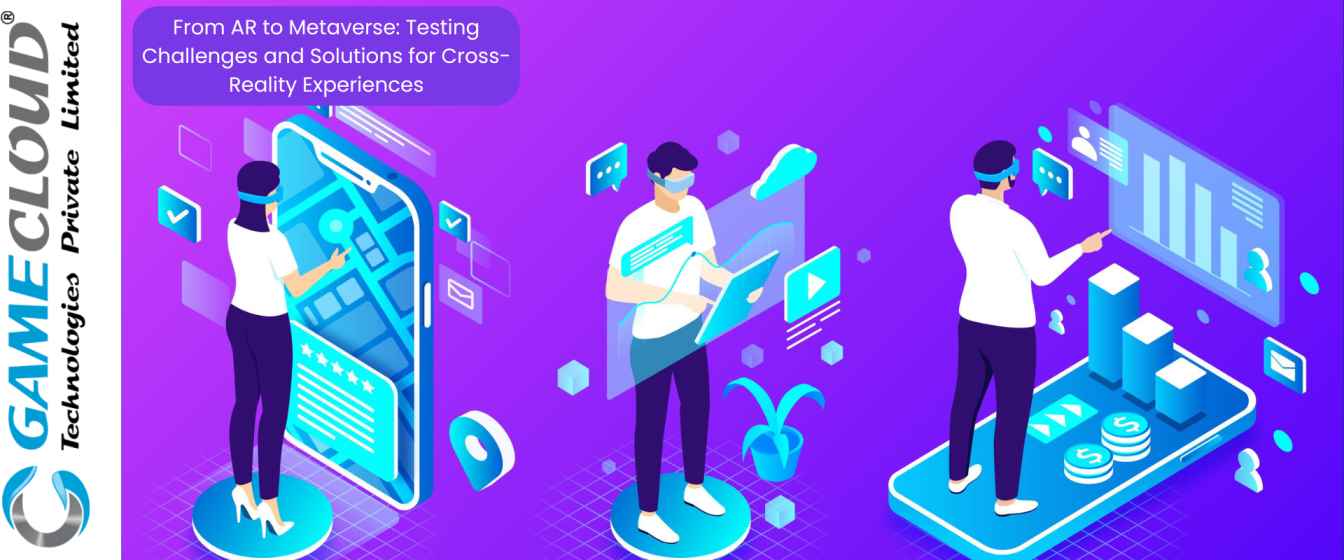
XR technologies, which encompass AR, VR, and now the broader concept of the Metaverse, are transforming how we interact with the digital and physical worlds. This technology evolution offers immersive, interactive experiences across sectors, from education and entertainment to healthcare and retail. XR’s rapid growth, accelerated by advances in hardware and connectivity, points toward a future where digital layers enrich our physical surroundings seamlessly.
As these technologies converge into interconnected Metaverse platforms, ensuring a smooth and immersive experience becomes essential. Testing in these cross-reality environments presents unique challenges, such as device compatibility, real-time responsiveness, and privacy considerations. This shift requires adaptable testing solutions to support the ever-evolving demands of XR users, ensuring that immersive experiences are both engaging and reliable for all.
Key Testing Challenges in Cross-Reality Environments
XR environments, from AR to the Metaverse, involves addressing several key challenges:
- Compatibility and Performance Testing: XR experiences must be optimized for various devices with differing hardware capabilities. Testers need to validate consistent functionality across platforms, as XR applications are highly device-dependent, with frequent software updates complicating matters.
- Latency and Real-Time Responsiveness: Low latency is essential for immersive experiences in XR. Even slight delays can disrupt immersion, making continuous testing under varied network conditions crucial.
- UI/UX Testing: Testing for intuitive user interactions is vital in XR, where standard screens and buttons are replaced by gestures and voice commands. This requires rigorous checks to ensure virtual elements respond accurately.
- Environmental Testing: XR applications are sensitive to surroundings, from lighting to spatial setups. Testing in diverse conditions is essential to ensure reliability across scenarios.
- Security and Privacy: Given XR’s real-time data requirements, rigorous security testing is needed to safeguard sensitive data within immersive environments.
Solutions and Best Practices for Effective Cross-Reality Testing
In cross-reality environments, ensuring effective testing requires a strategic mix of tools and collaborative frameworks:
- Simulation and Automation Tools: Advanced simulation tools can replicate diverse real-world conditions, enabling both manual and automated testing. Many tools like AR/VR-specific testing frameworks support developers in creating stable XR environments while saving time on repetitive tests by automating them across devices.
- Collaborative Testing Frameworks: Involving various stakeholders—from developers to end-users—in collaborative frameworks creates a comprehensive testing environment. These frameworks enable early identification of issues, ensuring XR applications are optimized for real-world usage.
- User-Centric Testing and Feedback Loops: Continuous user feedback helps refine interactions and address UI/UX challenges unique to XR. Regular iterations based on user insights improve overall usability.
- Innovative Testing Labs: Controlled labs allow testing under varied conditions, including lighting and spatial changes, which are essential for reliable XR performance across different environments.
- Privacy and Security Protocols: Stringent security testing integrated throughout development helps ensure data protection and user privacy, vital in real-time data-sharing XR applications. Testing tools like automated penetration tests and dynamic data masking support secure, compliant XR deployments across platforms.
These practices ensure immersive, safe, and responsive experiences across AR and Metaverse applications.
Elevating Immersive Experiences: Quality Testing for XR and the Metaverse
At QualityReality, the Metaverse and XR division of GameCloud Technologies Private Limited, we’re dedicated to advancing XR and Metaverse experiences through comprehensive testing solutions. From functional and performance checks to user experience testing, we ensure that your AR, VR, and MR applications work flawlessly across various platforms. Our team tackles compatibility, performance, and interaction testing to deliver immersive, high-quality experiences. With specialized testing environments and tools, we prioritize both functionality and security, helping developers launch polished and reliable products that truly engage users.
Conclusion
In conclusion, testing in XR environments requires addressing complex challenges, from compatibility to user privacy. As AR, VR, MR, and the Metaverse evolve, adaptive and forward-thinking testing approaches are essential. Embracing innovative testing methodologies will support future advancements, ensuring immersive, secure, and seamless cross-reality experiences for users as technology continues to progress.
For Know More Contact-Now
FAQs for: From AR to Metaverse: Testing Challenges and Solutions for Cross-Reality Experiences
What are the main challenges in testing XR (AR, VR, and Metaverse) applications?
The key challenges in testing XR applications include ensuring compatibility across different devices, achieving low latency for real-time responsiveness, testing intuitive user interfaces that rely on gestures and voice commands, and ensuring privacy and security in immersive environments. These challenges require tailored testing approaches to deliver seamless experiences.
How do testers ensure that XR applications perform well across different devices?
Testers focus on compatibility and performance testing to ensure XR applications function consistently across a wide range of devices with varying hardware capabilities. They use simulation and automation tools to replicate real-world conditions, which helps validate functionality and optimize the app for diverse platforms.
What role does latency play in XR applications, and how is it tested?
Latency is crucial in XR applications because even slight delays can disrupt the immersive experience. To test for latency, continuous testing under varying network conditions is conducted to ensure that the application remains responsive and provides a smooth, real-time interaction without interruptions.
What are the best practices for testing user interfaces in XR applications?
User interface (UI) testing in XR involves ensuring that virtual elements, such as gestures and voice commands, are responsive and intuitive. Testers use user-centric feedback loops, iterating on designs based on real user experiences to refine interactions and address any UI/UX challenges unique to XR environments.
How do developers ensure privacy and security in XR applications?
Privacy and security are critical in XR environments due to the real-time sharing of sensitive data. Developers integrate rigorous security protocols throughout the development process, using tools like automated penetration tests and dynamic data masking to safeguard user information and ensure compliance with privacy standards.
